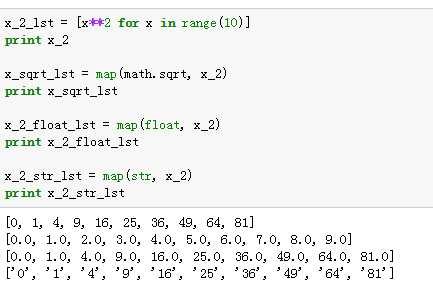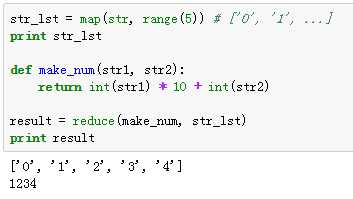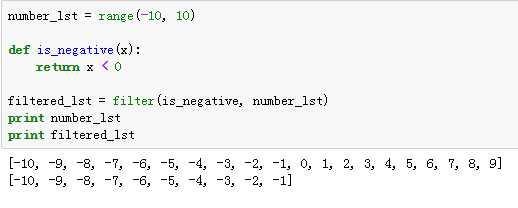标签:一个 key sof 输出 匿名函数 index 针对 filter 编写
语法:[exp for item in collection if codition]

语法:{key_exp:value_exp for item in collection if codition}

语法:{exp for item in collection if codition}


2、匿名函数lambda

1、map/reduce函数


lst = [a1, a2 ,a3, ......, an]
reduce(func(x,y), lst) = func(func(func(a1, a2), a3), ......, an)

2、filter函数

默认情况下,nditer将视待迭代遍历的数组为只读对象(read-only),为了在遍历数组的同时,实现对数组元素值得修改,必须指定op_flags=[‘readwrite‘]模式:
np.nditer(a, op_flags=[‘readwrite‘])
基本迭代参数flag=[‘f_index‘/‘mulit_index‘],可输出自身坐标it.index/it.multi_index:
a = np.arange(6).reshape(2,3) ‘‘‘迭代方式‘‘‘ # 单维迭代 it = np.nditer(a, flags=[‘f_index‘]) while not it.finished: print("%d <%s>" % (it[0], it.index)) it.iternext() #0 <0> #1 <2> #2 <4> #3 <1> #4 <3> #5 <5> # 多维迭代 it = np.nditer(a, flags=[‘multi_index‘]) while not it.finished: print("%d <%s>" % (it[0], it.multi_index)) it.iternext() #0 <(0, 0)> #1 <(0, 1)> #2 <(0, 2)> #3 <(1, 0)> #4 <(1, 1)> #5 <(1, 2)>
改变迭代的顺序:
# 列顺序迭代 it = np.nditer(a, flags=[‘f_index‘], order=‘F‘) while not it.finished: print("%d <%s>" % (it[0], it.index), end=‘ | ‘) it.iternext() # 0 <0> | 3 <1> | 1 <2> | 4 <3> | 2 <4> | 5 <5> | # 行顺序迭代 it = np.nditer(a, flags=[‘f_index‘], order=‘C‘) while not it.finished: print("%d <%s>" % (it[0], it.index), end=‘ | ‘) it.iternext() # 0 <0> | 1 <2> | 2 <4> | 3 <1> | 4 <3> | 5 <5> |
ufunc是universal function的缩写,它是一种能对数组的每个元素进行操作的函数。NumPy内置的许多ufunc函数都是在C语言级别实现的,因此它们的计算速度非常快。
通过组合标准的ufunc函数的调用,可以实现各种算式的数组计算。不过有些时候这种算式不易编写,而针对每个元素的计算函数却很容易用Python实现,这时可以用frompyfunc函数将一个计算单个元素的函数转换成ufunc函数。这样就可以方便地用所产生的ufunc函数对数组进行计算了。让我们来看一个例子。
我们想用一个分段函数描述三角波,三角波的样子如下图所示:

三角波可以用分段函数进行计算
我们很容易根据上图所示写出如下的计算三角波某点y坐标的函数:
def triangle_wave(x, c, c0, hc): x = x - int(x) # 三角波的周期为1,因此只取x坐标的小数部分进行计算 if x >= c: r = 0.0 elif x < c0: r = x / c0 * hc else: r = (c-x) / (c-c0) * hc return r
显然triangle_wave函数只能计算单个数值,不能对数组直接进行处理。我们可以用下面的方法先使用列表包容(List comprehension),计算出一个list,然后用array函数将列表转换为数组:
x = np.linspace(0, 2, 1000) y = np.array([triangle_wave(t, 0.6, 0.4, 1.0) for t in x])
这种做法每次都需要使用列表包容语法调用函数,对于多维数组是很麻烦的。让我们来看看如何用frompyfunc函数来解决这个问题:
triangle_ufunc = np.frompyfunc( lambda x: triangle_wave(x, 0.6, 0.4, 1.0), 1, 1) y2 = triangle_ufunc(x)
frompyfunc的调用格式为frompyfunc(func, nin, nout),其中func是计算单个元素的函数,nin是此函数的输入参数的个数,nout是此函数的返回值的个数。虽然triangle_wave函数有4个参数,但是由于后三个c, c0, hc在整个计算中值都是固定的,因此所产生的ufunc函数其实只有一个参数。为了满足这个条件,我们用一个lambda函数对triangle_wave的参数进行一次包装。这样传入frompyfunc的函数就只有一个参数了。这样子做,效率并不是太高,另外还有一种方法:
def triangle_func(c, c0, hc): def trifunc(x): x = x - int(x) # 三角波的周期为1,因此只取x坐标的小数部分进行计算 if x >= c: r = 0.0 elif x < c0: r = x / c0 * hc else: r = (c-x) / (c-c0) * hc return r # 用trifunc函数创建一个ufunc函数,可以直接对数组进行计算, 不过通过此函数 # 计算得到的是一个Object数组,需要进行类型转换 return np.frompyfunc(trifunc, 1, 1) y2 = triangle_func(0.6, 0.4, 1.0)(x)
我们通过函数triangle_func包装三角波的三个参数,在其内部定义一个计算三角波的函数trifunc,trifunc函数在调用时会采用triangle_func的参数进行计算。最后triangle_func返回用frompyfunc转换结果。
值得注意的是用frompyfunc得到的函数计算出的数组元素的类型为object,因为frompyfunc函数无法保证Python函数返回的数据类型都完全一致。因此还需要再次 y2.astype(np.float64)将其转换为双精度浮点数组。
标签:一个 key sof 输出 匿名函数 index 针对 filter 编写
原文地址:http://www.cnblogs.com/hellcat/p/7081828.html